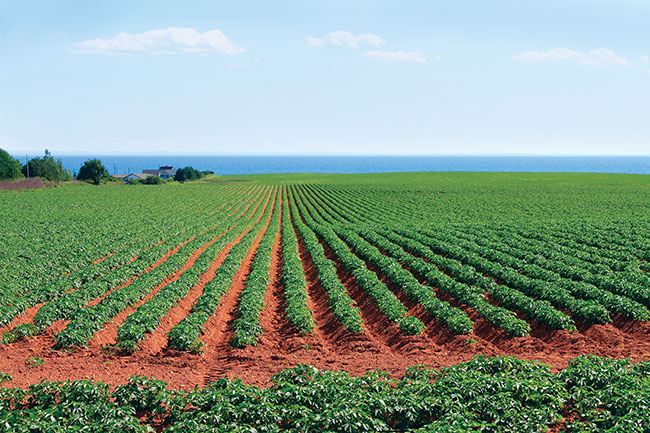
Features
Features
State of the industry provided during Canadian Potato Summit
Yields for 2022 were above five-year average.
March 7, 2023 By Potatoes in Canada Staff
 A potato field in P.E.I., where despite the impact of Hurricane Fiona, growers had a good growing season in 2022.
Photo: gvictoria / adobe stock.
A potato field in P.E.I., where despite the impact of Hurricane Fiona, growers had a good growing season in 2022.
Photo: gvictoria / adobe stock. The Canadian Potato Summit returned in January for another successful virtual event, with a range of speakers addressing such topics as disease, nitrogen dynamics in the potato root zone and an overall review of the industry for 2022 and going forward.
For 2022, Canadian potato crop yields were above the five-year average at 322 hundredweight per acre compared to 320 in 2021 and 293 in 2020. The five-year average sits at 311.
Production estimates were up 9.4 per cent over the five-year average, at 122,970 million hundredweight.
In Ontario, Shawn Brenn, president of Brenn-B Farms in Waterdown, Ont., says the province’s planting season was good, with few interrupters and excellent conditions.
After planting, however, there was variability across Ontario mostly due to differing weather.
“It just really depends regionally on where you are located if you got those rains or you didn’t,” says Brenn. “August was very hot for everyone, so there were certainly times when the crop was stressed.”
Once the crop was put in the bins, reports from growers were similar to the province’s weather, being somewhat inconsistent.
“Not the best year for Ontario potato growers, but it certainly could have been worse,” says Brenn.
Greg Donald, general manager of the P.E.I. Potato Board, says 2022 was up and down for growers in the province, with shipping restrictions to the U.S. due to the potato wart issue front and centre.
“When the border did open, we experienced significant demand, movement was brisk,” says Donald, adding that losses from the border closure were around 300 million pounds. “When the border opened, things quickly returned, and we couldn’t keep up with the demand.”
The start of P.E.I.’s growing season was like Ontario’s, with a good spring and adequate rain, but Hurricane Fiona triggered a “glitch” in September, which delayed harvest time.
“We had great harvest weather,” Donald says of after Fiona, “And had a very comparable crop to 2021. Growers were very happy with the yield.”
Pink diseases
Gary Secor, a professor of plant pathology at North Dakota State University, led off the summit, providing a comparison of potato diseases that have similar symptoms and can therefore be difficult to identify.
Focusing on diseases one would see during storage or immediately after harvest, Secor highlighted “pink” diseases, such as pink rot, pink eye, late blight and rubbery rot.
“These all have some common symptoms that can have some overlap and can cause some confusion,” says Secor. “They all have some aspect of a pink colour in their symptom development, and they all usually produce some white growth on the skin of the tubers…and oftentimes the eyes are affected.”
With pink rot, infection first occurs in the field, and no wound is necessary for infection, unlike many of the other diseases. Tuber tissue turns salmon pink after cutting and exposure to air for approximately 15 minutes. The tissue is also soft and fluoresce under UV light. Wet conditions favour pink rot, and there is limited spread in storage but there is an ammonia smell while in storage.
The cause of pink eye, Secor says, is unknown, as it primarily affects the bud end of the tuber, is also associated with wet conditions and in storage and a cork tissue accumulates making the tuber difficult to peel.
Late blight is a problem anywhere potatoes are grown and is the most serious potato disease worldwide, says Secor. It is a community disease, meaning it spreads far and fast and can cause serious economic loss. Cool, wet weather spawns late blight, affecting all parts of the plant above and below ground with symptoms that are not always clear.
Rubbery rot is considered a new player on the potato disease front, with some European countries and the U.S. reporting cases.
Caused by a yeast-like fungus, rubbery rot makes the potato feel rubbery and damp to the touch and can display a reddish tinge. Other symptoms can include a sour milk odor, patches of white mycelium on the tuber surface and is associated with warm, waterlogged soils near harvest time.
The Canadian Potato Summit is a half-day virtual event that launched in 2021 with live sessions that focus on the industry and agronomy updates from leaders in the potato sector.
Print this page